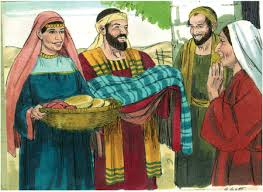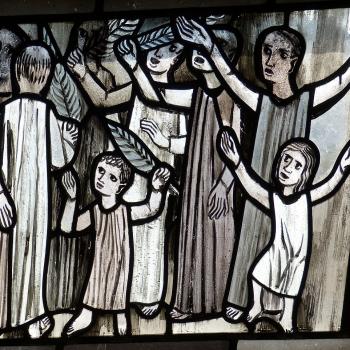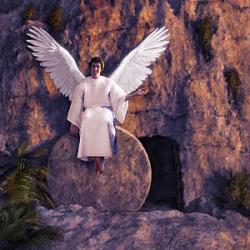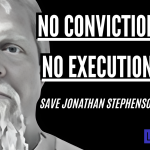Doubt is Next to Godliness
Last Friday’s post imagined a conversation between Karl Marx and Jesus in which they discuss a passage or two from Richard Rorty’s essay “Failed Prophecies, Glorious Hope,” an essay that just happened to be the focus of class discussion in my American Philosophy class last week.
One of Rorty’s many interesting and controversial claims in that essay is that “We should read [The Communist Manifesto and the New Testament] as inspirational documents, appeals to what Lincoln called the ‘better angels of our nature,’ rather than as accurate accounts of human history or of human decency.” I opened the class with one of my favorite texts from the New Testament, one that regularly suprises and often offends my students–most of whom have never read or heard the passage.

Now the whole group of those who believed were of one heart and soul, and no one claimed private ownership of any possessions, but everything they owned was held in common. With great power the apostles gave their testimony to the resurrection of the Lord Jesus, and great grace was upon them all. There was not a needy person among them, for as many as owned lands or houses sold them and brought the proceeds of what was sold. They laid it at the apostles’ feet, and it was distributed to each as any had need.
Unquestioned Assumptions
After we read the passage together off a PowerPoint slide, I asked the students how they would describe this passage from Acts that describes how early communities of Jesus followers chose to organize themselves economically. “Socialism!” was the first response, not surprisingly. I have used this text many times over the years in class to poke at the unquestioned assumptions carried by students who, often coming from a faith-based upbringing in an upper middle class or wealthy household, have come to believe that somehow, as if by magic, their capitalist free-market attachments and their background framework of religious values will fit seamlessly together. “They sound like a bunch of communists!” more than one student has remarked in shock, and indeed they (anachronistically) do.
In some liturgical years, this passage from Acts is paired with today’s gospel from John. The familiar story of “Doubting Thomas” is the Second Sunday of Easter reading for all three liturgical years. In spite of the bad rap Thomas has gotten over the centuries for being the one disciple loser who refused to believe that Jesus had risen until he had seen him and touched him first person (of course, none of the other disciples believed until they had first-hand contact either, but let’s not go there), he is one of my all-time heroes.
Sterile Religion
By both personality and profession, I am naturally skeptical–I think that doubt is closer to godliness than cleanliness is. Just as I take the great skeptic Michel de Montaigne as a model for how to do philosophy, I consider Thomas as one of my models for how to approach the life of faith, something I share with many of my spiritual guides ranging from Kathleen Norris, Christian Wiman and Joan Chittister to Anne Lamott, Rowan Williams and Barbara Brown Taylor. Most homilies about this gospel draw the moral of the story from Jesus’ gentle criticism of Thomas’ attitude: “Have you believed because you have seen me? Blessed are those who have not seen and yet have come to believe.” But there is seeing and then there is seeing. Except for a select few, those who have committed themselves to Jesus in any way over the centuries have never seen him physically. But without a direct encounter—without truly seeing something worth committing to—faith commitment can easily become sterile religion.
Why, I have often wondered (and have often asked my students), did the early Christian communities choose to organize themselves in the manner described in Acts? They are close enough in time to Jesus’ physical presence that undoubtedly some of their members actually knew him in the flesh, or at least knew some people who did. But if the vision is not going to fade, such communities cannot rely on first-hand remembrance of the source. Practices and attitudes reflective of the values the community is committed to must be embedded in the very fiber and structure of the common life of the group.
Walk Humbly
At some point, given that a new community of followers of Jesus was seeking both stability and faithfulness to the message, someone must have asked “How would Jesus have organized this community if he were here?” Somebody remembers the parables, another person recalls the Beatitudes, and pretty soon they become a small, primitive laboratory for living the Gospel in real time. How to truly become Jesus in community form? By putting into action what the man supposedly said and lived. Feed the hungry. Clothe the naked. Shelter the homeless. Love each other as God loves us. This wasn’t church for them—this was life. Most likely their very survival depended on it.
Two thousand years later, persons who profess a Christian faith share a lot in common with these early followers of Jesus. We have not seen Jesus in the flesh, just as most—and pretty soon all—of the members of these early communities had not. We are bound together by having seen Jesus in ways far deeper and more profound than physical vision. And our challenge is the same as theirs, to figure out what it means to actually live it rather than just say it. As I often do, I fall back here on the prophetic words of Micah who asked, just as these early communities did, just as we do today, “What does the Lord require of us?” Do justice. Love mercy. Walk humbly with your God. And, I might add, doubt is an appropriate seasoning for each of these.
















